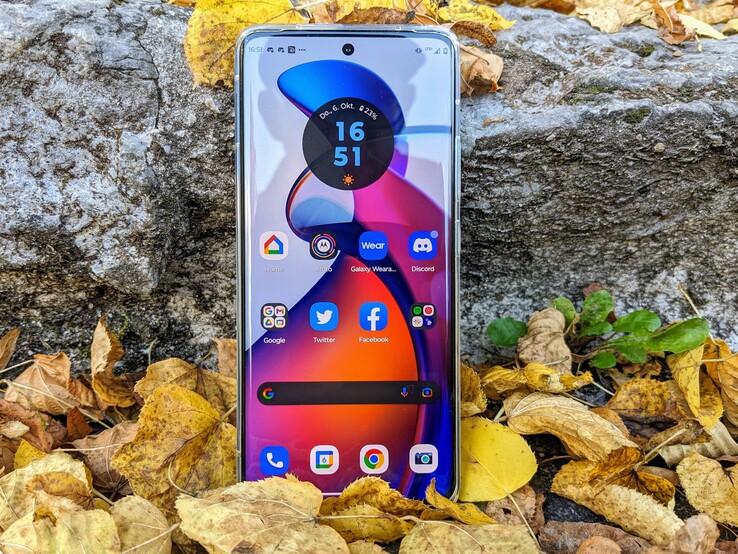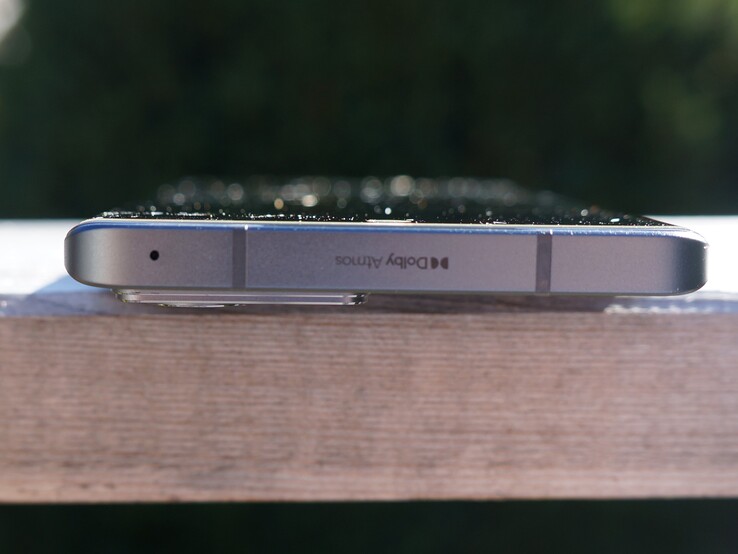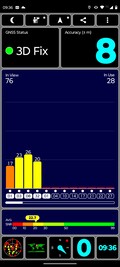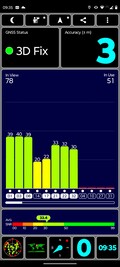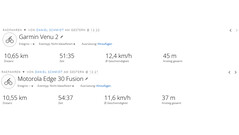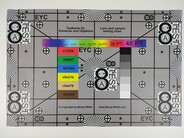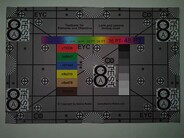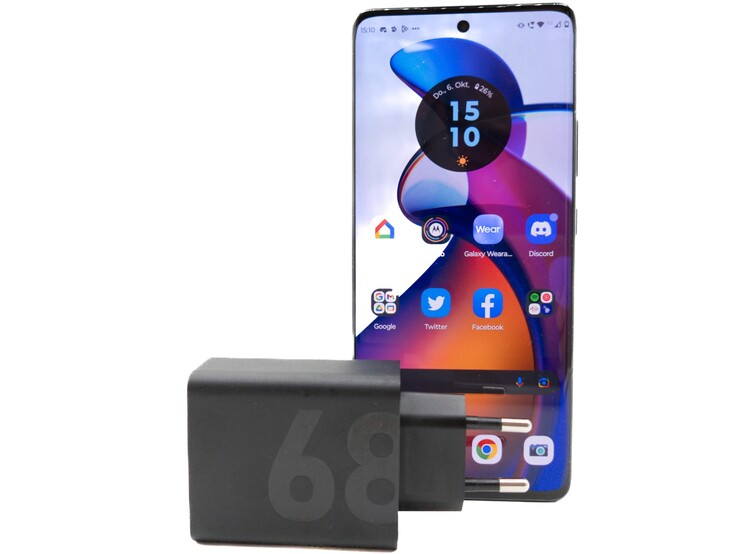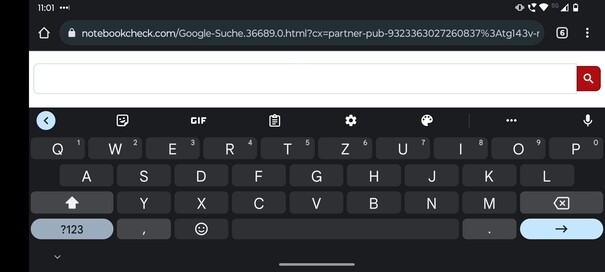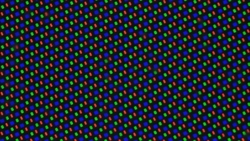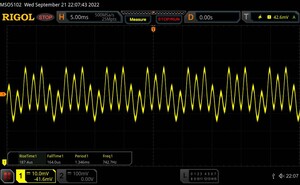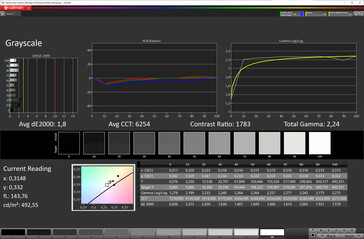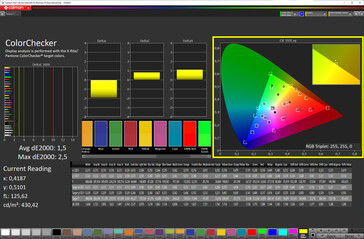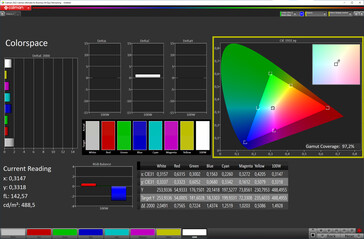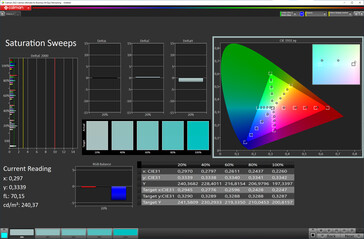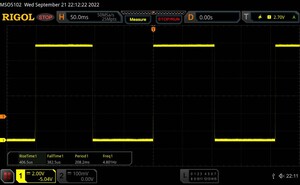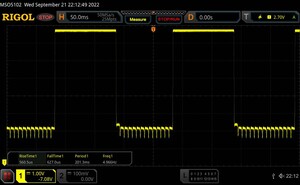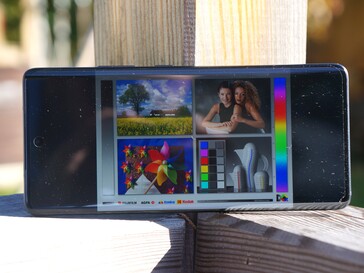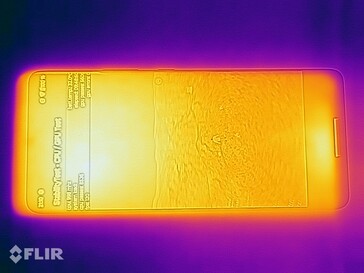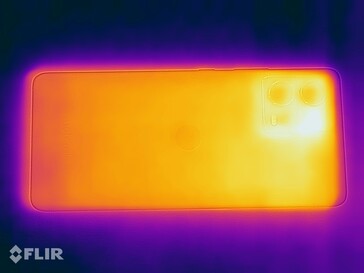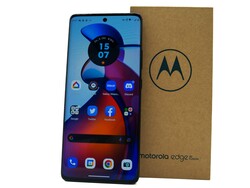Motorola Edge 30 Fusion smartphone review - Not high-end, but really good
Motorola is expanding the Edge 30 family considerably. Besides the well-known Edge 30 and Edge 30 Pro, there are three new models: Ultra, Neo, and Fusion. While the Neo is in the mid-range and the Ultra in the high-end area, the Fusion looks for its place in between. The Edge 30 Fusion is only available in a configuration with 128 GB of storage and 8 GB of RAM. The available colors are "Cosmic Grey", "Aurora White" and "Vegan Leather".
Possible competitors in comparison
Rating | Date | Model | Weight | Drive | Size | Resolution | Price |
|---|---|---|---|---|---|---|---|
| 87.4 % v7 (old) | 10 / 2022 | Motorola Edge 30 Fusion SD 888+ 5G, Adreno 660 | 172 g | 128 GB UFS 3.1 Flash | 6.55" | 2400x1080 | |
| 87.4 % v7 (old) | 11 / 2021 | Google Pixel 6 Tensor, Mali-G78 MP20 | 207 g | 128 GB UFS 3.1 Flash | 6.40" | 2400x1080 | |
| 88.8 % v7 (old) | 02 / 2022 | Samsung Galaxy S21 FE 5G SD 888 5G, Adreno 660 | 177 g | 128 GB UFS 3.1 Flash | 6.40" | 2340x1080 | |
| 87.7 % v7 (old) | 03 / 2022 | Xiaomi 12 SD 8 Gen 1, Adreno 730 | 179 g | 256 GB UFS 3.1 Flash | 6.28" | 2400x1080 |
Case - Edge 30 Fusion with aluminum and glass
Motorola's Edge 30 Fusion comes with an elongated casing, and the display has a 20:9 ratio, which makes it pleasantly slim in the hand. The 6.5-inch display is rounded on the sides, as is the back, which results in narrow side edges. The frame of the Fusion is made of aluminum, and the back is made of glass; Corning Gorilla Glass 5 is used for the display.
The camera module clearly protrudes from the back, which is why the device wobbles when it is placed on a table. The wobble does not completely disappear even with the included case. The smartphone's gaps are very small and even. Except for the wobbling of the volume rocker on the review sample, there is nothing to complain about in terms of build quality. The device has an IP52 certification.
Features - Dual-SIM but no memory expansion
The Motorola Edge 30 Fusion is dual-SIM capable and accepts two nano-SIM cards; eSIM is not supported. A memory expansion via microSD card is missing, as is a jack. In return, the smartphone has stereo speakers that are Dolby Atmos certified.
All buttons of the device are positioned on the right side. The power button can be reached easily, and the volume down button is also within the thumb's reach. However, you have to reach for the volume up button. The optical fingerprint reader is located in the display.
Software - Vanilla Android Feeling with Moto enhancements
The Motorola Edge 30 Fusion comes with Android 12 and Motorola's My UX. The software is largely the same as stock Android with some enhancements. There is support for typical Moto gestures, such as shaking to activate the flashlight function. Besides numerous Google apps, only TikTok is preinstalled and can be easily deleted.
Another special feature is Motorola's "Ready for". This establishes a connection between the smartphone and a PC, screen, or TV, via USB cable or wirelessly via WLAN. The Fusion then serves as a computer and all programs are displayed on a desktop. It is also possible to move files between devices.
During the test period, the device received the security update for September, before that the July patch was installed. Therefore, a three-month interval for security updates can be expected. Motorola promises three years of security patches and two years of OS updates.
Communication and GNSS - Edge 30 Fusion masters Wi-Fi 6E
Motorola's Edge 30 Fusion supports 5G with both SIM cards. The reception was inconspicuous during the test. The frequency coverage in the different radio standards is good. All relevant bands for Germany and Europe are supported.
The smartphone can handle the current Wi-Fi 6E standard. The measurements with our reference router, the Asus ROG GT-AXE1000, show transmission rates that correspond to the class standard. The connection is established quickly. However, there are a few drops in the 6 GHz range.
| Networking | |
| iperf3 receive AXE11000 | |
| Samsung Galaxy S21 FE 5G | |
| Xiaomi 12 | |
| Motorola Edge 30 Fusion | |
| Average of class Smartphone (52 - 1857, n=180, last 2 years) | |
| iperf3 transmit AXE11000 | |
| Motorola Edge 30 Fusion | |
| Xiaomi 12 | |
| Samsung Galaxy S21 FE 5G | |
| Average of class Smartphone (49.8 - 1806, n=180, last 2 years) | |
| iperf3 transmit AXE11000 6GHz | |
| Motorola Edge 30 Fusion | |
| Xiaomi 12 | |
| Average of class Smartphone (508 - 1945, n=84, last 2 years) | |
| iperf3 receive AXE11000 6GHz | |
| Xiaomi 12 | |
| Average of class Smartphone (451 - 1864, n=84, last 2 years) | |
| Motorola Edge 30 Fusion | |
| iperf3 transmit AX12 | |
| Google Pixel 6 | |
| iperf3 receive AX12 | |
| Google Pixel 6 | |
The Motorola Edge 30 Fusion features dual GNSS. The connection to the satellite system is established quickly outdoors as well as indoors. The smartphone convinces with high accuracy.
The comparison with our reference device, the Garmin Venu 2, shows a convincing satellite connection. The route is displayed accurately on the map, and turns and curves are also recorded smoothly.
Telephony and call quality - Clear communication
The voice quality of the Motorola Edge 30 Fusion during the call is very good. Voices are rendered clearly from both sides, and the earpiece gets loud. Ambient noise is filtered out well, Motorola calls this feature "ChrystalTalk AI". Calls via WLAN are possible.
Google's software is used as the phone app. The program is clearly structured and well-arranged.
Camera - Edge 30 Fusion with 8K videos
The 50 MPix main camera is especially convincing in the camera setup of Motorola's Edge 30 Fusion. The pictures are rich in detail, the color reproduction is good, and mostly quite natural. The pictures taken with the main camera are warmer than those taken with the 13-MP ultra-wide-angle camera. The ultra-wide-angle pictures are still good in themselves, although details are missing in comparison.
The Edge 30 Fusion offers a Pro mode for photos, that lets the user adjust the focus manually, as well as the white balance, exposure time, and ISO values.
The pictures of the 32-MP front-facing camera are pleasing, they are sharp and natural. The camera normally works with pixel binning to 8 MP. The portrait mode works quickly and reliably in most cases, but there are occasionally areas that are mismatched - like in the test photos.
Video recordings with the main camera are possible with a resolution of up to 8K. However, the recordings quickly become shaky. On the other hand, video stabilization ensures smooth videos in Full HD resolution. The FPS cannot be adjusted manually though. The wide-angle camera only records videos in FHD, while 4K resolution is possible for the front-facing camera.
Image comparison
Choose a scene and navigate within the first image. One click changes the position on touchscreens. One click on the zoomed-in image opens the original in a new window. The first image shows the scaled photograph of the test device.
Main cameraMain cameraWide-angle5x ZoomLow-LightOverall, the color balance of Motorola's camera is pleasing. Only the green tones show larger deviations, as the comparison with ColorChecker shows. The lens still captures a lot of light in controlled light conditions of only one lux.
The sharpness of the pictures taken with the main camera is good, only towards the edges does it weaken. In low light, the sharpness is also convincing: even details are well visible and there is hardly any image noise.
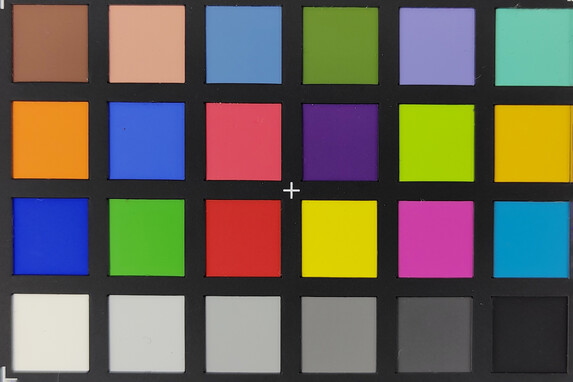
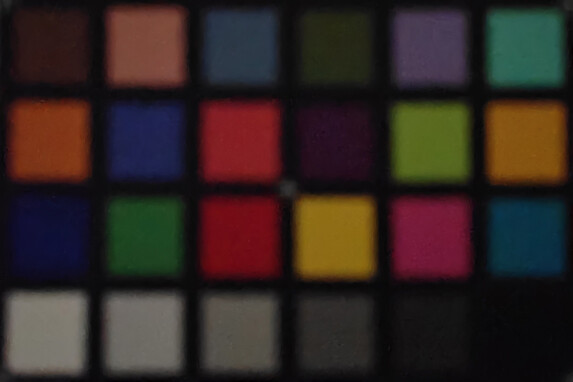
Accessories and warranty - Motorola adds a 68-watt power adapter
The Edge 30 Fusion comes with a 68-watt power adapter with a matching USB-C to USB-C cable. Motorola also provides a transparent, soft plastic case. A screen protector is applied ex-works.
Motorola grants a warranty of 24 months for smartphone in Germany. With the Moto Care program, an extension of the warranty period by one year and accident protection is possible.
Input devices & operation - Fast in-display fingerprint scanner
Motorola relies on the Gboard keyboard for text input with the Edge 30 Fusion. The software is convincing in both portrait and landscape modes, and there are hardly any typos.
A protective film is applied to the touchscreen ex-works, but it comes off at the corners after a short time. Despite the film, the gliding properties are very good. The slightly rounded shape of the display does not interfere with operation. The general operating speed is very good.
The Edge 30 Fusion can be unlocked via fingerprint or face recognition in addition to pin or pattern input. The optical fingerprint reader is integrated into the display. It is located closer to the bottom of the screen but works quickly and reliably. The less secure 2D face unlock is just as reliable, but it takes about one second until the smartphone is unlocked.
Display - Bright OLED in the Edge 30 Fusion
Motorola installs a 6.55-inch OLED display in 20:9 format in the Edge 30 Fusion. The panel is rounded on the sides. Due to the design, the screen impresses with perfect black level and contrasts. Furthermore, the panel is pleasantly bright; our measurements result in a maximum brightness (APL18) of 1,196 cd/m² with the ambient light sensor turned on. With the sensor disabled, 525 cd/m² is possible.
We could not determine temporal dithering on the smartphone. For testing, the display is filmed through a microscope at 240 fps with an iPhone. However, the display test shows PWM with a brightness level of up to 68%. At full display brightness and in DC dimming mode, the measured value is 144 Hz and thus corresponds to the refresh rate. At 50% brightness, the frequency is a high 753 Hz.
The maximum refresh rate is 144 Hz. The user can switch between permanent 60 Hz, 144 Hz, or an automatic adjustment by the software. Then the panel can also display content at 48, 90, and 120 Hz. Unfortunately, the Edge 30 Fusion does not offer an always-on display. In addition, the outermost edge areas occasionally show image errors in full-screen mode, for example when gaming.
| |||||||||||||||||||||||||
Brightness Distribution: 98 %
Center on Battery: 954 cd/m²
Contrast: ∞:1 (Black: 0 cd/m²)
ΔE ColorChecker Calman: 1.5 | ∀{0.5-29.43 Ø4.82}
ΔE Greyscale Calman: 1.8 | ∀{0.09-98 Ø5.1}
97.2% sRGB (Calman 2D)
Gamma: 2.24
CCT: 6254 K
| Motorola Edge 30 Fusion pOLED, 2400x1080, 6.6" | Google Pixel 6 OLED, 2400x1080, 6.4" | Samsung Galaxy S21 FE 5G Dynamic AMOLED 2X, 2340x1080, 6.4" | Xiaomi 12 OLED, 2400x1080, 6.3" | |
|---|---|---|---|---|
| Screen | -12% | -16% | -18% | |
| Brightness middle | 954 | 805 -16% | 758 -21% | 867 -9% |
| Brightness | 961 | 805 -16% | 758 -21% | 867 -10% |
| Brightness Distribution | 98 | 98 0% | 99 1% | 98 0% |
| Black Level * | ||||
| Colorchecker dE 2000 * | 1.5 | 1.4 7% | 1.5 -0% | 1.7 -13% |
| Colorchecker dE 2000 max. * | 2.5 | 3.7 -48% | 3.1 -24% | 4.4 -76% |
| Greyscale dE 2000 * | 1.8 | 1.8 -0% | 2.3 -28% | 1.8 -0% |
| Gamma | 2.24 98% | 2.29 96% | 2.06 107% | 2.2 100% |
| CCT | 6254 104% | 6507 100% | 6378 102% | 6762 96% |
* ... smaller is better
Screen Flickering / PWM (Pulse-Width Modulation)
| Screen flickering / PWM detected | 753 Hz | ||
The display backlight flickers at 753 Hz (worst case, e.g., utilizing PWM) . The frequency of 753 Hz is quite high, so most users sensitive to PWM should not notice any flickering. In comparison: 53 % of all tested devices do not use PWM to dim the display. If PWM was detected, an average of 8291 (minimum: 5 - maximum: 343500) Hz was measured. | |||
Measurement series with fixed zoom level and different brightness settings
The color balance of Motorola's panel is convincing. The deviation is not noticeable in the grayscale as well as in the colors.
Display Response Times
| ↔ Response Time Black to White | ||
|---|---|---|
| 0.79 ms ... rise ↗ and fall ↘ combined | ↗ 0.4065 ms rise | |
| ↘ 0.3825 ms fall | ||
| The screen shows very fast response rates in our tests and should be very well suited for fast-paced gaming. In comparison, all tested devices range from 0.1 (minimum) to 240 (maximum) ms. » 1 % of all devices are better. This means that the measured response time is better than the average of all tested devices (20.4 ms). | ||
| ↔ Response Time 50% Grey to 80% Grey | ||
| 1.19 ms ... rise ↗ and fall ↘ combined | ↗ 0.5605 ms rise | |
| ↘ 0.627 ms fall | ||
| The screen shows very fast response rates in our tests and should be very well suited for fast-paced gaming. In comparison, all tested devices range from 0.165 (minimum) to 636 (maximum) ms. » 4 % of all devices are better. This means that the measured response time is better than the average of all tested devices (32 ms). | ||
The readability of the display from different viewing angles is very good. There are no distortions or color changes.
Performance - Previous year's processor in Motorola smartphone
The Motorola Edge 30 Fusion comes with the former high-end processor Snapdragon 888 Plus in combination with an Adreno 660 Graphics unit. This is not the latest processor in the smartphone - the Edge 30 Ultra has one. Nevertheless, the Edge 30 Fusion convinces with an extremely smooth performance in everyday use. Apps are opened quickly, and switching between different apps is always possible without stuttering.
The benchmark results are diverse. In AnTuTu 9 and Geekbench 5.4, the Fusion is only beaten by the Xiaomi 12 with the Snapdragon 8 Gen 1 and is ahead of the average of all devices with the Snapdragon 888 Plus. In CrossMark and PCMark benchmarks, however, the smartphone has to place itself in the midfield.
In any case, the SoC has enough performance reserves to cope with the upcoming OS updates.
| UL Procyon AI Inference for Android - Overall Score NNAPI | |
| Motorola Edge 30 Fusion | |
| Average Qualcomm Snapdragon 888 Plus 5G (27949 - 32339, n=3) | |
| Google Pixel 6 | |
| Average of class Smartphone (3769 - 81594, n=140, last 2 years) | |
| AImark - Score v2.x | |
| Average Qualcomm Snapdragon 888 Plus 5G (27321 - 286905, n=3) | |
| Xiaomi 12 | |
| Google Pixel 6 | |
| Samsung Galaxy S21 FE 5G | |
The Motorola Edge 30 Fusion is equipped with the Adreno 660 is used as the graphics unit. The performance is convincing. The device can place itself at the top of the comparison field in various benchmarks, such as 3DMark Sling Shot Extreme Unlimited.
Current games, such as PUBG Mobile, run smoothly even in the highest available settings (Ultra HD / frame rate Extreme).
The fast UFS 3.1 memory in Motorola's Edge 30 Fusion is convincing. The rates - especially in sequential reading - are very good and, with the exception of the Xiaomi 12, are far ahead of the rivals.
GFXBench (DX / GLBenchmark) 2.7: T-Rex Onscreen | 1920x1080 T-Rex Offscreen
GFXBench 3.0: on screen Manhattan Onscreen OGL | 1920x1080 1080p Manhattan Offscreen
GFXBench 3.1: on screen Manhattan ES 3.1 Onscreen | 1920x1080 Manhattan ES 3.1 Offscreen
GFXBench: on screen Car Chase Onscreen | 1920x1080 Car Chase Offscreen | on screen Aztec Ruins High Tier Onscreen | 2560x1440 Aztec Ruins High Tier Offscreen | on screen Aztec Ruins Normal Tier Onscreen | 1920x1080 Aztec Ruins Normal Tier Offscreen
| 3DMark / Wild Life Extreme Unlimited | |
| Xiaomi 12 | |
| Google Pixel 6 | |
| Motorola Edge 30 Fusion | |
| Samsung Galaxy S21 FE 5G | |
| 3DMark / Wild Life Extreme | |
| Xiaomi 12 | |
| Google Pixel 6 | |
| Motorola Edge 30 Fusion | |
| Samsung Galaxy S21 FE 5G | |
| 3DMark / Wild Life Unlimited Score | |
| Xiaomi 12 | |
| Google Pixel 6 | |
| Samsung Galaxy S21 FE 5G | |
| Motorola Edge 30 Fusion | |
| 3DMark / Wild Life Score | |
| Xiaomi 12 | |
| Google Pixel 6 | |
| Motorola Edge 30 Fusion | |
| Samsung Galaxy S21 FE 5G | |
| 3DMark / Sling Shot Extreme (Vulkan) Unlimited Physics | |
| Xiaomi 12 | |
| 3DMark / Sling Shot Extreme (Vulkan) Unlimited Graphics | |
| Xiaomi 12 | |
| 3DMark / Sling Shot Extreme (Vulkan) Unlimited | |
| Xiaomi 12 | |
| 3DMark / Sling Shot Extreme (ES 3.1) Unlimited Physics | |
| Motorola Edge 30 Fusion | |
| Samsung Galaxy S21 FE 5G | |
| Xiaomi 12 | |
| Google Pixel 6 | |
| 3DMark / Sling Shot Extreme (ES 3.1) Unlimited Graphics | |
| Xiaomi 12 | |
| Samsung Galaxy S21 FE 5G | |
| Motorola Edge 30 Fusion | |
| Google Pixel 6 | |
| 3DMark / Sling Shot Extreme (ES 3.1) Unlimited | |
| Xiaomi 12 | |
| Motorola Edge 30 Fusion | |
| Samsung Galaxy S21 FE 5G | |
| Google Pixel 6 | |
| 3DMark / Sling Shot OpenGL ES 3.0 Physics | |
| Xiaomi 12 | |
| 3DMark / Sling Shot OpenGL ES 3.0 Graphics | |
| Xiaomi 12 | |
| 3DMark / Sling Shot OpenGL ES 3.0 | |
| Xiaomi 12 | |
| 3DMark / Sling Shot Extreme (ES 3.1) | |
| Xiaomi 12 | |
| 3DMark / Sling Shot Extreme (ES 3.1) Graphics | |
| Xiaomi 12 | |
| 3DMark / Sling Shot Extreme (ES 3.1) Physics | |
| Xiaomi 12 | |
| 3DMark / Sling Shot OpenGL ES 3.0 Unlimited | |
| Motorola Edge 30 Fusion | |
| Samsung Galaxy S21 FE 5G | |
| Xiaomi 12 | |
| Google Pixel 6 | |
| 3DMark / Sling Shot OpenGL ES 3.0 Unlimited Graphics | |
| Xiaomi 12 | |
| Motorola Edge 30 Fusion | |
| Samsung Galaxy S21 FE 5G | |
| Google Pixel 6 | |
| 3DMark / Sling Shot OpenGL ES 3.0 Unlimited Physics | |
| Motorola Edge 30 Fusion | |
| Samsung Galaxy S21 FE 5G | |
| Xiaomi 12 | |
| Google Pixel 6 | |
| GFXBench (DX / GLBenchmark) 2.7 / T-Rex Onscreen | |
| Xiaomi 12 | |
| Samsung Galaxy S21 FE 5G | |
| Google Pixel 6 | |
| GFXBench (DX / GLBenchmark) 2.7 / T-Rex Offscreen | |
| Xiaomi 12 | |
| Samsung Galaxy S21 FE 5G | |
| Google Pixel 6 | |
| GFXBench 3.0 / Manhattan Onscreen OGL | |
| Motorola Edge 30 Fusion | |
| Xiaomi 12 | |
| Samsung Galaxy S21 FE 5G | |
| Google Pixel 6 | |
| GFXBench 3.0 / 1080p Manhattan Offscreen | |
| Xiaomi 12 | |
| Motorola Edge 30 Fusion | |
| Samsung Galaxy S21 FE 5G | |
| Google Pixel 6 | |
| GFXBench 3.1 / Manhattan ES 3.1 Onscreen | |
| Xiaomi 12 | |
| Motorola Edge 30 Fusion | |
| Samsung Galaxy S21 FE 5G | |
| Google Pixel 6 | |
| GFXBench 3.1 / Manhattan ES 3.1 Offscreen | |
| Xiaomi 12 | |
| Motorola Edge 30 Fusion | |
| Samsung Galaxy S21 FE 5G | |
| Google Pixel 6 | |
| GFXBench / Car Chase Onscreen | |
| Xiaomi 12 | |
| Motorola Edge 30 Fusion | |
| Samsung Galaxy S21 FE 5G | |
| Google Pixel 6 | |
| GFXBench / Car Chase Offscreen | |
| Xiaomi 12 | |
| Motorola Edge 30 Fusion | |
| Samsung Galaxy S21 FE 5G | |
| Google Pixel 6 | |
| GFXBench / Aztec Ruins High Tier Onscreen | |
| Xiaomi 12 | |
| Samsung Galaxy S21 FE 5G | |
| Google Pixel 6 | |
| Motorola Edge 30 Fusion | |
| GFXBench / Aztec Ruins High Tier Offscreen | |
| Xiaomi 12 | |
| Samsung Galaxy S21 FE 5G | |
| Motorola Edge 30 Fusion | |
| Google Pixel 6 | |
| GFXBench / Aztec Ruins Normal Tier Onscreen | |
| Xiaomi 12 | |
| Motorola Edge 30 Fusion | |
| Samsung Galaxy S21 FE 5G | |
| Google Pixel 6 | |
| GFXBench / Aztec Ruins Normal Tier Offscreen | |
| Xiaomi 12 | |
| Motorola Edge 30 Fusion | |
| Samsung Galaxy S21 FE 5G | |
| Google Pixel 6 | |
| Jetstream 2 - 2.0 Total Score | |
| Average of class Smartphone (13.8 - 387, n=153, last 2 years) | |
| Xiaomi 12 (Chrome 99.0.4844.58) | |
| Motorola Edge 30 Fusion (Chrome 105) | |
| Average Qualcomm Snapdragon 888 Plus 5G (75.9 - 125.4, n=4) | |
| Google Pixel 6 (Chrome 96) | |
| Samsung Galaxy S21 FE 5G (Chrome 96) | |
| Speedometer 2.0 - Result | |
| Average of class Smartphone (15.2 - 585, n=136, last 2 years) | |
| Xiaomi 12 (Chrome 99.0.4844.58) | |
| Google Pixel 6 (Chrome 96) | |
| Average Qualcomm Snapdragon 888 Plus 5G (79.8 - 114, n=3) | |
| Samsung Galaxy S21 FE 5G (Chrome 96) | |
| WebXPRT 4 - Overall | |
| Average of class Smartphone (22 - 273, n=146, last 2 years) | |
| Motorola Edge 30 Fusion (Chrome 105) | |
| Average Qualcomm Snapdragon 888 Plus 5G (n=1) | |
| WebXPRT 3 - Overall | |
| Average of class Smartphone (38 - 347, n=55, last 2 years) | |
| Xiaomi 12 (Chrome 99.0.4844.58) | |
| Average Qualcomm Snapdragon 888 Plus 5G (120 - 165, n=3) | |
| Samsung Galaxy S21 FE 5G (Chrome 96) | |
| Google Pixel 6 (Chrome 96) | |
| Octane V2 - Total Score | |
| Average of class Smartphone (2228 - 100368, n=203, last 2 years) | |
| Google Pixel 6 (Chrome 96) | |
| Average Qualcomm Snapdragon 888 Plus 5G (28695 - 49046, n=4) | |
| Motorola Edge 30 Fusion (Chrome 105) | |
| Xiaomi 12 (Chrome 99.0.4844.58) | |
| Samsung Galaxy S21 FE 5G (Chrome 96) | |
| Mozilla Kraken 1.1 - Total | |
| Samsung Galaxy S21 FE 5G (Chrome 96) | |
| Average Qualcomm Snapdragon 888 Plus 5G (1118 - 1443, n=4) | |
| Average of class Smartphone (277 - 28190, n=157, last 2 years) | |
| Motorola Edge 30 Fusion (Chrome 105) | |
| Google Pixel 6 (Chrome 96) | |
| Xiaomi 12 (Chrome 99.0.4844.58) | |
* ... smaller is better
| Motorola Edge 30 Fusion | Google Pixel 6 | Samsung Galaxy S21 FE 5G | Xiaomi 12 | Average 128 GB UFS 3.1 Flash | Average of class Smartphone | |
|---|---|---|---|---|---|---|
| AndroBench 3-5 | -41% | -7% | 49% | -6% | 55% | |
| Sequential Read 256KB | 1870.18 | 1546 -17% | 1639 -12% | 1851 -1% | 1581 ? -15% | 2200 ? 18% |
| Sequential Write 256KB | 689.24 | 233.4 -66% | 760 10% | 1417 106% | 742 ? 8% | 1802 ? 161% |
| Random Read 4KB | 248.86 | 126.2 -49% | 245.1 -2% | 325.2 31% | 242 ? -3% | 296 ? 19% |
| Random Write 4KB | 276.74 | 190.3 -31% | 211.2 -24% | 437.5 58% | 238 ? -14% | 341 ? 23% |
Emissions - Motorola has the Snapdragon under control
Temperature - The Edge 30 Fusion stays cool
Even under full load, the Motorola Edge 30 Fusion never gets hot. We measured a maximum of 34.7 degrees in the stress test. The temperatures are significantly lower in normal use. The device only gets noticeably warm during charging, but never uncomfortably hot.
(+) The maximum temperature on the upper side is 34.7 °C / 94 F, compared to the average of 35.2 °C / 95 F, ranging from 21.9 to 247 °C for the class Smartphone.
(+) The bottom heats up to a maximum of 34.1 °C / 93 F, compared to the average of 33.9 °C / 93 F
(+) In idle usage, the average temperature for the upper side is 28.6 °C / 83 F, compared to the device average of 32.9 °C / 91 F.
3DMark Wild Life Stress Test
| 3DMark | |
| Wild Life Stress Test Stability | |
| Motorola Edge 30 Fusion | |
| Xiaomi 12 | |
| Wild Life Extreme Stress Test | |
| Motorola Edge 30 Fusion | |
| Xiaomi 12 | |
Speakers - Clear stereo sound in the Edge 30 Fusion
The sound of the Dolby Atmos-certified stereo speakers is convincing. On the one hand, the device can get really loud (88.9 dB). On the other hand, the speakers create very balanced mids and trebles. The reproduction of music and voices is nice and clear, and the speakers do not become tinny. Only basses and low frequencies are not reproduced or are reproduced weakly. The center of the device vibrates slightly at full volume.
An audio jack is missing.
Motorola Edge 30 Fusion audio analysis
(+) | speakers can play relatively loud (88.9 dB)
Bass 100 - 315 Hz
(-) | nearly no bass - on average 24.9% lower than median
(±) | linearity of bass is average (8.1% delta to prev. frequency)
Mids 400 - 2000 Hz
(+) | balanced mids - only 2.9% away from median
(+) | mids are linear (4.5% delta to prev. frequency)
Highs 2 - 16 kHz
(+) | balanced highs - only 3.4% away from median
(+) | highs are linear (3.2% delta to prev. frequency)
Overall 100 - 16.000 Hz
(+) | overall sound is linear (14.7% difference to median)
Compared to same class
» 1% of all tested devices in this class were better, 2% similar, 97% worse
» The best had a delta of 12%, average was 36%, worst was 134%
Compared to all devices tested
» 18% of all tested devices were better, 4% similar, 78% worse
» The best had a delta of 4%, average was 24%, worst was 134%
Xiaomi 12 audio analysis
(+) | speakers can play relatively loud (90.7 dB)
Bass 100 - 315 Hz
(-) | nearly no bass - on average 19.3% lower than median
(±) | linearity of bass is average (8.2% delta to prev. frequency)
Mids 400 - 2000 Hz
(±) | higher mids - on average 5% higher than median
(+) | mids are linear (4.7% delta to prev. frequency)
Highs 2 - 16 kHz
(±) | higher highs - on average 7.5% higher than median
(+) | highs are linear (4.7% delta to prev. frequency)
Overall 100 - 16.000 Hz
(±) | linearity of overall sound is average (17.3% difference to median)
Compared to same class
» 10% of all tested devices in this class were better, 8% similar, 82% worse
» The best had a delta of 12%, average was 36%, worst was 134%
Compared to all devices tested
» 31% of all tested devices were better, 8% similar, 61% worse
» The best had a delta of 4%, average was 24%, worst was 134%
Battery life - Motorola with a good energy values
Energy consumption
Motororola shows a solid performance in the Edge 30 Fusion's energy consumption. In normal use, the Fusion is in the midfield of its rivals. The performance under load is particularly good, as Motorola's smartphone is pleasantly frugal.
| Off / Standby | |
| Idle | |
| Load |
|
Key:
min: | |
| Motorola Edge 30 Fusion 4400 mAh | Google Pixel 6 4614 mAh | Samsung Galaxy S21 FE 5G 4500 mAh | Xiaomi 12 4500 mAh | Average Qualcomm Snapdragon 888 Plus 5G | Average of class Smartphone | |
|---|---|---|---|---|---|---|
| Power Consumption | -5% | -27% | -18% | -1% | -40% | |
| Idle Minimum * | 0.83 | 0.68 18% | 1.01 -22% | 0.87 -5% | 0.65 ? 22% | 0.864 ? -4% |
| Idle Average * | 1.72 | 1 42% | 1.5 13% | 1.7 1% | 1.353 ? 21% | 1.428 ? 17% |
| Idle Maximum * | 1.75 | 1.02 42% | 1.6 9% | 1.82 -4% | 1.565 ? 11% | 1.589 ? 9% |
| Load Average * | 2.76 | 5.39 -95% | 5.54 -101% | 4.68 -70% | 4.03 ? -46% | 7.2 ? -161% |
| Load Maximum * | 6.74 | 9 -34% | 9.16 -36% | 7.41 -10% | 7.54 ? -12% | 10.8 ? -60% |
* ... smaller is better
Power consumption: Geekbench (150 cd/m²)
Power consumption: GFXBench (150 cd/m²)
Battery life - Edge 30 Fusion with super charging times
The Edge 30 Fusion does not make any mistakes in terms of battery life either. Although it has the smallest battery among the comparison devices, it beats the Google Pixel 6 in the realistic Wi-Fi web surfing test and the Samsung Galaxy S21 FE also stays behind. The smartphone lasts for one day even during intensive use and short game sessions. If the Fusion is not used much, two days of use without recharging is possible.
The charging speed of Motorola's Edge 30 Fusion in combination with the 68-watt charger is impressive. This charges the smartphone from 10 to 50 percent in 10 minutes. The charging process from 10 to 100 percent only takes 36 minutes.
| Battery Runtime - WiFi Websurfing (sort by value) | |
| Motorola Edge 30 Fusion | |
| Google Pixel 6 | |
| Samsung Galaxy S21 FE 5G | |
| Xiaomi 12 | |
Pros
Cons
Verdict- Motorola's successful overall concept
Motorola convinces all along the line with the Edge 30 Fusion. The large OLED panel offers great contrasts and gets nice and bright. The elongated form factor and the Edge display are a matter of taste. However, not only the display is convincing, but the performance of the SoC is also right and is sufficient for both gaming and extremely smooth operation, an impression that is reinforced by the 144 Hz refresh rate. Thanks to the good stereo speakers, gaming and videos are great fun on the smartphone.
Those who can do without the latest processor, extreme megapixel resolutions, and a zoom lens do not need more than the Edge 30 Fusion.
The Fusion's main camera does not offer the 200 MPix of the Edge 30 Ultra but still takes sharp pictures and even convinces in unfavorable light conditions. The smartphone can also record videos in 8K, but it is better to use a tripod in that case.
Thus, the Edge 30 Fusion is a successful overall package without any real weaknesses, and it even comes with a powerful charger. Motorola's smartphone does not have to hide from the competition in any discipline. It beats the chosen comparison devices - Samsung Galaxy S21FE and Google Pixel 6 - in many disciplines. On par is the Xiaomi 12 which is even more compact and has a more up-to-date processor under the hood.
Price and availability
Motorola Edge 30 Fusion
- 10/10/2022 v7 (old)
Benedikt Winkel




